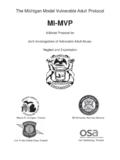Transcription of Hampshire and Isle of Wight Neglect Strategy
1 W. E OF IGHT. ISL. SA. RD. GU A. FE. AR BO. DING N. CHILDRE. Hampshire and Isle of Wight Neglect Strategy 2016/18. A Partnership Approach Contents 1. Why do we need a Strategy ?..6. Scope of the Purpose of the Strategy ..6. Case 2. Strategic 3. Tackling Neglect : A Strategic National principles in tackling Role of the Local Children Board (LSCB).. 10. Common risk factors indicators of 10. Good practice principles in tackling 13. Reviewing and auditing 15. Workforce 15. 4. Picture of Neglect .. 16. What the national research tells 16. The four types of Neglect and how they 16. 5. Guide to recognising Neglect in 18. 6. Governance and 22. 7. Useful Resources .. 23. 8. Appendix 1: A guide to recognising Neglect in 24. 2 Hampshire and Isle of Wight Neglect Strategy 2016/18. Foreword Awareness of child Neglect and its consequences on the future wellbeing and development of children has increased during the last two decades.
2 Apart from being potentially fatal, Neglect causes great distress to children and leads to poor health, educational and social outcomes in the short and long-term (NSPCC, 2014). Consequences can include an array of health and mental health problems, difficulties in forming attachment and relationships, lower educational achievements, an increased risk of substance misuse, higher risk of experiencing abuse as well as difficulties in assuming parenting responsibilities later on in life (Taylor and Bridge 2005), thereby repeating the cycle of Neglect and consequential abuse. The degree to which children are affected during their childhood and later in adulthood depends on the type, severity and frequency of the Neglect and on what support mechanisms, resilience strategies and protective factors were available to the child.
3 Neglect has been identified as a priority for the Hampshire and Isle of Wight safeguarding children boards because of the serious impact it has on the long-term chances for children. Neglect in the first three years of life can seriously impact on brain development and have significant consequences through adolescence and into adulthood. The purpose of this document is to establish strategic aims, objectives and priorities for Hampshire and the Isle of Wight 's approach in tackling Neglect . It was developed through the Local Safeguarding Children Boards and as such applies to all agencies across all sectors working on the Isle of Wight and in Hampshire . This document identifies both the current statutory definition of Neglect and other factors to consider in assisting and further supporting practitioners in early identification and intervention.
4 This Strategy is intended as a practical guide to identify a number of guiding principles under which all work around Neglect should be undertaken. It also identifies four strategic priority areas in order to improve the quality, reach and scope of the response to Neglect . This Strategy recognises the four types of Neglect (Howe, D 2005) are a means by which better understanding will be gained of what causes Neglect : Emotional Neglect Disorganised Neglect Depressed or passive Neglect Severe deprivation. Hampshire and Isle of Wight Neglect Strategy 2016/18 3. 4 Hampshire and Isle of Wight Neglect Strategy 2016/18. 1. Introduction Definition The NSPCC (2014) provides the following definition of child Neglect : A persistent failure to meet a child's basic physical and/or developmental needs. Neglect includes failing to provide for a child's health, education, emotional development, nutrition, clothing, shelter, safety and safe living conditions, and includes exclusion of the child from the home and abandonment.
5 According to the World Health Organisation (WHO) Neglect is different from poverty1 because it happens when there is a failure to provide the resources to meet a child's needs if those resources exist or should be available. Working Together 2015 (HM Government)2 describes Neglect as including: a parent's or guardian's failure to provide adequate food, clothing and shelter, such as excluding a child from the home, abandoning them and leaving them alone failure to protect a child from physical or emotional harm, or danger failure to ensure that the child has adequate supervision (including the use of inadequate and inappropriate caregivers). failure to ensure the child has access to appropriate medical care and treatment when needed unresponsiveness to a child's basic emotional needs Neglect is defined developmentally, so that a parent or guardian failing to do or to provide certain things will have a detrimental impact on the development or safety of a young child, but not necessarily on an older child.
6 A child who is neglected will often suffer from other abuses as well. Neglect is dangerous and can cause serious, long-term damage - even death3. There is a considerable body of research which demonstrates the damage done to young children living in situations of Neglect ; this includes the impact of a lack of stimulation, resulting in delayed speech and language, and the development of insecure attachments4. There is a pervasive and long-term cumulative impact of Neglect on the well-being of children of all ages including physical and cognitive development, emotional and social well-being and children's mental health and behaviour56. Action for Children (2012) presents Neglect as differing from other forms of abuse because it is: Frequently passive Not always intentional More likely to be a chronic condition rather than crisis led and therefore impacts on how we respond as agencies Combined often with other forms of maltreatment Often a revolving door syndrome where families require long term support Often not clear-cut and may lack agreement between professionals on the threshold for intervention7.
7 1 For more information on the environment causes of Neglect see section of this Strategy . 2 HM Government (2015) Working Together to Safeguard Children: a Guide to Inter Agency Working to Safeguard and Promote the Welfare of Children, London, Department For Education 3 NSPCC (2015) accessed on 17 September 2015 via: 4 OFSTED (2014), In the child's time: professional responses to Neglect , Accessed on 2 October 2015 via: 5 C Davies and H Ward, Safeguarding children across services: messages from research, Department for Education, 2011;. 6 A Lazenbatt, The impact of abuse and Neglect on the health and mental health of children and young people, NSPCC Research briefing, 2010; accessed on 02/10/15 via: 7 Action for Children (2012), Working with Neglect : Practice toolkit, Action for Children 04/2012. 12/13 0020 accessed on 05/10/15 via: Hampshire and Isle of Wight Neglect Strategy 2016/18 5.
8 Why do we need a Strategy ? The impact of Neglect on children cannot be overestimated. Neglect causes great harm to children, leading to poor health, educational and social outcomes and is potentially fatal., Children's abilities to make secure attachments are affected and this impacts on their well-being in adulthood and their ability to parent in the future, and so the cycle continues8. For example, on the Isle of Wight (as at 31st March 2016) of the 213 children subject to a child protection plan of these were under the category of Neglect . Through this Strategy local partners agree on the following principles: The safety and welfare of children is paramount Professionals and volunteers from all agencies have a statutory responsibility to safeguard children from Neglect and its consequences. As such the aim of this Strategy is to tackle the causes and effects of Neglect in Hampshire and on the Isle of Wight .
9 In order to achieve this, the objectives of this Strategy are: To strengthen local responses in line with current national and local guidance, policies and good practice To adapt, rather than duplicate, existing guidance, policies or procedures to tackle Neglect . To raise awareness and improve the safeguarding duty of all relevant agencies with regards to Neglect Scope of the Strategy Neglect can affect everyone. The issue of Neglect with regards to vulnerable adults is addressed by the Safeguarding Adult Boards (SAB)9. This Strategy addresses Neglect in relation to children from conception to the age of 18. The organisations who are expected to understand, recognise and appropriately respond to the four types of Neglect are: Adult Services District and Borough Councils Housing Ambulance Service Education early years, primary, National Probation Service Animal Welfare Groups secondary, post-16, special NHS England schools, independent Children's Services NHS Trust Providers Environmental Health Clinical Commissioning Groups Opticians Faith Groups Community CAMHS Town and Parish Councils Fire Service Community Rehabilitation Youth Offending Teams Company General Practice Voluntary Groups Dentists Hampshire Constabulary Purpose of the Strategy The purpose of the Strategy is to set out Hampshire and the Isle of Wight 's approach to tackling Neglect .
10 This Strategy also identifies key principles and key priority areas of work in order to improve the local multi-agency response to Neglect . This document has been developed in conjunction with the partners represented on the Local Safeguarding Children Boards. This Strategy should be considered alongside other key strategies, policies and procedures, such as the local Early Help Strategies, the Levels of Need framework10, Female Genital Mutilation Strategy , Domestic Violence Strategy , Substance Misuse Strategy and guidance from professional bodies such as the Royal Pharmaceutical Society and the Optical Confederation (see Useful Resources' at the end of this Strategy document). 8 Liverpool Council (2014) Neglect Strategy 2014-16, accessed on 18/09/15 via: Liverpool's%20 Multi%20 Agency%20 Negelct%20 Strategy %202014%20-% 9 For more information on the role of the SAB see: Adults-Board and 10 See appendix 1: Different forms of Neglect and how they manifest.







